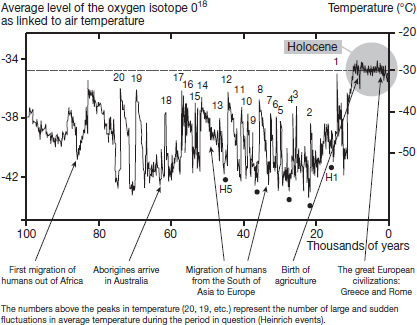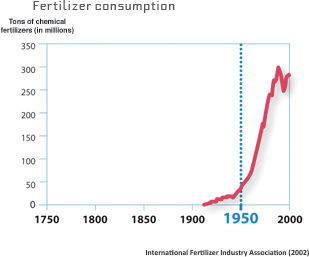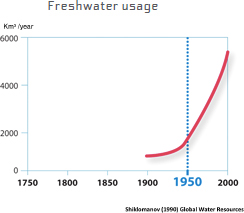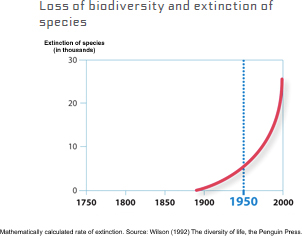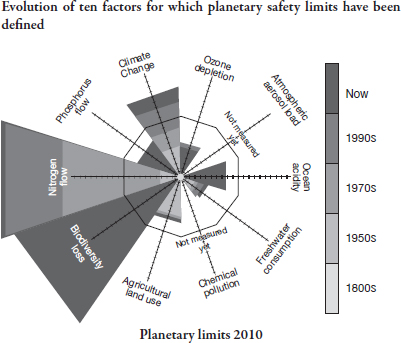41
ALTRUISM FOR THE SAKE OF FUTURE GENERATIONS
THE HOLOCENE: AN EXCEPTIONAL PERIOD FOR HUMAN PROSPERITY
For the last twelve thousand years, we have been living in a geological epoch known as the “Holocene,” a period characterized by extraordinary climate stability that has allowed the expansion of human civilization as we know it (see graphs below). These temperate conditions have provided the ideal environment for the development of agriculture and complex societies. It took just one thousand years or so for the majority of our semi-nomadic hunter-gatherer ancestors to settle ten thousand years ago.1
Before the Holocene, humans had great difficulty surviving. At one point they were even on the verge of extinction: DNA analysis of populations from around the world show that we probably descend from just two thousand individuals, the sole survivors of particularly harsh conditions in the sub-Saharan region around one hundred thousand years ago.2 We are the surviving members of an endangered species, and we owe that survival in large part to the unprecedented climate stability of the last ten thousand years. Before this, glacial periods and major climate instability limited population growth. Twelve thousand years ago, Earth was home to between 1 to 10 million human beings, and about 15 million five thousand years ago. It was only two thousand five hundred years ago that the 100 million threshold was crossed.3
During the ice age that preceded the Holocene, much of the Northern Hemisphere was covered in glaciers several kilometers thick, preventing the formation of any major human society and agricultural practice. Yet average temperatures were just 4 to 5 °C lower than they are today, which goes to show how temperature fluctuations that at first seem minimal are capable of bringing about radically different living conditions.
There have certainly been some minor climate variations during the Holocene—the warming in the year 1000 CE and the Little Ice Age at the start of the seventeenth century—but each time Earth has quickly restored balance.
The most likely reason for this exceptional climate stability of the past ten thousand years is that Earth’s orbit around the Sun has stayed especially constant—more or less circular—for twelve thousand years. Indeed variations in its orbit are considered to be a major cause of climate changes that have occurred in the past.4 This stability would persevere for at least twenty thousand years were it not threatened nowadays by humankind, which has triggered the most rapid climate change the planet has ever known. According to Will Steffen, director of the Climate Change Institute at the Australian National University: “The expanding human enterprise could undermine the resilience of the Holocene state, which would otherwise continue for thousands of years into the future.”5
WE HAVE EVERYTHING TO GAIN BY PRESERVING THIS FAVORABLE SITUATION
Up until the Industrial Revolution, Man’s influence on the environment was limited and easily absorbed by nature, which recycled the by-products of human activity on its own. The rise of agriculture was the main man-made transformation experienced by the planet. Yet it was inconceivable that any living species issued from the natural process of evolution could have the capacity to create major upheaval on a global scale.
But things have changed. Toward the middle of the eighteenth century, we acquired the ability to transform fossil fuels into cheap and effective energy sources, an innovation that led to unprecedented economic and social development. The capture and processing of nitrogen from the atmosphere into chemical products, fertilizers in particular, was also made possible by the use of energy from fossil fuels. Immense progress was made in the fields of health care, medicine, and living conditions in urban areas, leading to a population boom: 1 billion people inhabited the planet in 1800, compared with 7 billion today.
These new energy sources let man develop and exploit vast areas that had hitherto been wild, triggering in particular unprecedented deforestation. By 2011, half of Earth’s forest had been cut down, most of it in the last fifty years. Since 1990, half of the world’s tropical rainforest has been destroyed, and there is every possibility that it will disappear entirely in the next forty years.6
For the first time, a geological epoch’s characteristics are closely linked to human activity. Since 1950, we have effectively entered a new era that has become known as the Anthropocene, or “the human epoch,” the first in which the actions of humankind have been the primary factor shaping the planet, in a manner equivalent to the most severe forces of nature.
Why 1950? If we look at growth charts plotting various factors that have had an impact on the environment, it is clear that the 1950s represent what scientists have termed “the Great Acceleration.”7
The graphs below are telling: water consumption, the number of cars, deforestation, exploitation of marine resources, the use of chemical fertilizers, the level of CO2 and methane in the atmosphere, etc. are all increasing at a virtually exponential rate. You do not need to be a mathematical genius to grasp that it is inconceivable that this rate of growth can be sustained without creating major turmoil.
Sea levels are rising by a little over 3 millimeters per year, twice as quickly as in the twentieth century; the average temperature is threatening to increase by between 2°C (according to the most optimistic predictions) and 8°C (according to the least optimistic) before the end of this century. The 2014 synthesis from the UN Intergovernmental Panel on Climate Change (IPCC) concludes that unless drastic measures are taken, the increase of temperature is estimated to reach 3.7°C, which will make our planet a very different place to live. Ninety-five percent of the surface area of the world’s glaciers is reducing each year;8 deforestation is showing no sign of abating;9 and the oceans are getting warmer and more acidic as a result of excessive atmospheric levels of carbon dioxide, affecting sea life that has not experienced such pronounced change at any point in the last twenty-five million years. Nowadays, according to politician Anders Wijkman and executive director of the Stockholm Resilience Centre, Johan Rockström: “Anthropogenic pressures on the Earth System have reached a scale where abrupt global environmental change can no longer be excluded.”10
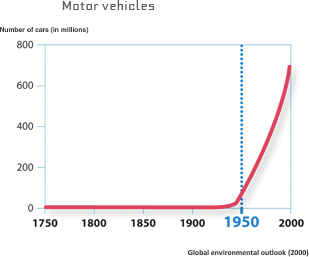
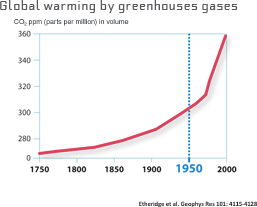
For the first time in history, in May 2013, CO2 levels reached 400 ppm.
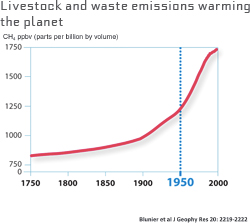
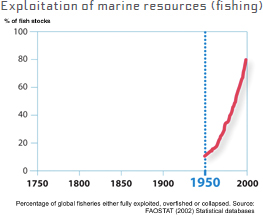

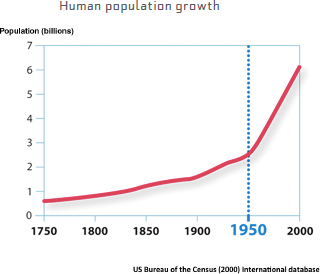
In 2007, in just a few months, the Arctic lost 30% of its sea ice cover in the summer, initiating what Mark Serreze, director of the National Snow and Ice Center, has called a “death spiral.”11 Generally speaking, the Arctic has warmed at least twice as quickly as the rest of the planet. This is because the ice reflects 85% of the light (and the resulting heat) it receives back into the atmosphere. By consequence, the more the ice melts, the faster the remaining ice melts. The same is true in the glaciers of the Himalayas, the “third pole” that has been tarnished by dust pollution and industrial fumes from the Indian subcontinent.
Thousands of scientists (97% of them) are united in expressing the view that if humankind does not quickly change its way of life, and if its response continues to be lacking, the planet risks reaching a “point of no return” that we will no longer be able to contain, destabilizing our climate and plunging our species into conditions that are not conducive to our survival. There are still some climate change skeptics (some 3% of scientists) who make a lot of noise in the media, but their arguments are devoid of substance, as we have already seen in chapter 35.
THE PLANETARY BOUNDARIES WITHIN WHICH HUMANITY CAN CONTINUE TO PROSPER
The concept of “planetary boundaries” was introduced and expounded in an article appearing in the journal Nature in 2009, signed by the Swede Johan Rockström and twenty-seven other internationally renowned scientists, among them the Nobel laureate Paul Crutzen, who was the first to rechristen our era the “Anthropocene.”12
According to Rockström: “Transgressing planetary boundaries would be devastating for humanity, but if we respect them we have a bright future for centuries to come.”13
If we remain within these boundaries, we can maintain a safety zone in which humanity can continue to prosper.
The study of Earth’s resilience, its complex dynamics, and its mechanisms for self-regulating living systems, has allowed the identification of “thresholds” which, if crossed, risk the advent of potentially irreversible “tips.”
There is of course a degree of uncertainty in the assessment of these boundaries, but what is certain is that the biosphere has entered a danger zone, like a motorist who, driving along a road in the fog toward a precipice, does not know the exact distance at which it will be too late to brake.
What’s more, these boundaries are closely interdependent, and if one were to be crossed it could trigger a domino effect that would accelerate the toppling of the others. Ocean acidification, for example, is closely linked to climate change, by virtue of the fact that a quarter of the additional carbon dioxide generated by humans dissolves in the ocean, where it forms carbonic acid that inhibits the ability of coral, mollusks, crustaceans, and plankton to build their shells and skeletons. The acidification of the ocean’s surface has increased by 30% since the start of the Industrial Revolution. It is now happening one hundred times faster than it has at any point in the last twenty million years, causing severe damage to coral reefs.14
The impoverishment of biodiversity is particularly severe. At the rate things are going, as much as 30% of mammals, birds, and amphibians are at risk of extinction before the end of the twenty-first century.15 According to the WWF, there has been a 52% decline in wildlife populations worldwide between 1970 and 2010. Freshwater animals, like frogs, showed an average decline of 79%, marine species of 39% (especially among marine turtles, many shark species, and large migratory seabirds such as the wandering albatross), and land-dwellers, like the African elephant, of 30%.18 The extinction rate has sped up by a factor of 100 to 1,000 because of human activity in the twentieth century, compared to the average rate (not counting major catastrophes, such as the one that led to the extinction of the dinosaurs). In the twenty-first century, this rate is expected to multiply by tenfold again. These are not things that can be fixed.
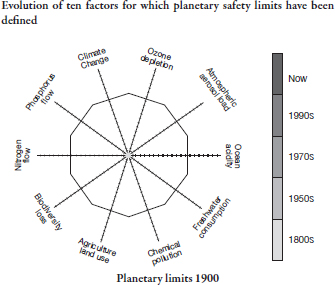
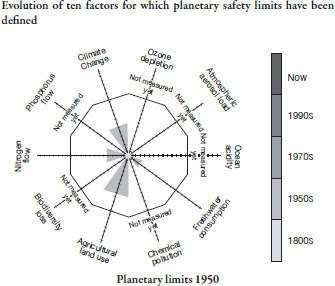
As for chemical products, “persistent organic pollutants,” heavy metals, and radioactive material, all of them have harmful and cumulative effects on biological organisms, reducing fertility and causing permanent genetic damage. These pollutants have already caused the decline of several animal species, sea birds, and an especially large proportion of mammals. Humans themselves are not spared. In 2004, ministers from thirteen European Union countries agreed to have their blood tested. Fifty-five chemical products were detected, ranging from products used on non-stick pans to plastics and perfumes, and even some pesticides that are illegal in Europe. All the ministers had traces of PCB in their blood, a toxic substance manufactured by Monsanto that was banned in Europe in the 1970s.19
This planet is resilient, in so far as it is capable of reacting to upsets, just like a mammal can, for example, regulate and maintain its body temperature, even if the temperature outside is fluctuating. Nevertheless, it has its limits. The nitrogen and phosphorous cycles have been profoundly disrupted. Modern agricultural techniques and the inadequate handling of urban waste now release more nitrogen into the biosphere than all of Earth’s processes combined. Only a small number of the pesticides used in farming are made from plants; as such, most nitrogen and phosphorous ends up in rivers, lakes, and the sea, where they disrupt aquatic ecosystems.20
THE FUTURE’S NOT SO BAD… FOR NOW
The vast majority of Tibetans I know have never heard of global warming; they all know, however, that the winter ice is less thick than it was in the past, and that temperatures are rising. Elsewhere in the world, in places with free access to information, a good number of us are aware of the dangers posed by global warming, but we hold back from taking any of the necessary measures to curb it.
Evolution has endowed us with ways of reacting energetically to imminent threats, but it is harder for us to feel concern for a problem that will come about in ten or twenty years. We tend to take the “we’ll see when we get there” attitude.
We are even less inclined to take into account the environmental effects of our way of life on future generations. We often refuse to consider going without instant pleasures since it means envisaging disastrous consequences that will most likely happen in the long term. Diana Liverman, a respected environmental scientist, has lamented that CO2 isn’t pink in color. If everyone could see the sky getting pinker and pinker with the more CO2 we emitted, we would in all likelihood feel increasingly alarmed at the effect it was having.21
American Indians used to say that, before making an important decision, one had to imagine the effects that decision would have on the people not just of their generation but seven generations down the line. Nowadays, it is hard enough to persuade decision-makers to take an interest in the threats facing the next generation. As for ultraliberal economists, they are only interested in the relationships between producers and consumers, and remain willfully blind to the fact that unbridled access to energy and natural resources cannot continue forever. Today, two-thirds of the world’s most important ecosystems are overexploited,22 and, according to Pavan Sukhdev, the Indian banker and leader of the study called The Economics of Ecosystems and Biodiversity, or TEEB: “We are consuming the past, present and future of the biosphere in an unthinking rush that we call progress and GDP.”23
THE SCALE OF THE CHALLENGE
In 2013, concentrations of carbon dioxide increased at their fastest rate for 30 years. Between 1990 and 2013 there was a 34% increase in “radiative forcing,” the warming effect on our climate due to long-lived greenhouse gases such as carbon dioxide, methane and nitrous oxide.24
Despite the protestations of the skeptic camp, average temperatures have also been continually on the increase, as we will see below.25 At the rate things are going, in Africa in 2050 there will be a 50% to 80% probability that the following summer will be the hottest on record (since measurements began in 1900), and this probability will approach 100% by the end of the twenty-first century.26
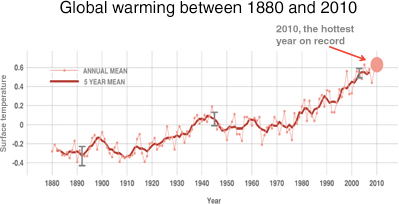
A large part of the uncertainty surrounding the extent of this warming is founded on the possibility that this sudden acceleration has been brought about by a combination of different factors. A study published in 2010 by Natalia Shakhova and her colleagues at the International Arctic Research Center shows, for example, that methane emissions due to the melting of the Siberian tundra’s permafrost are much greater than previously estimated.27
But a warming of the climate by just 1.5°C would lead to major changes affecting human societies. Food resources would diminish, several contagious diseases sensitive to temperature would increase, and population migrations triggered by climate change would bring about much conflict. The number of refugees would be around the 200 million mark.
Sea levels, which have been measured since 1993 by satellite, are rising by 3.3 millimeters per year, and, because of this acceleration, could go up by 80 centimeters by 2100, forcing entire populations to emigrate.28 Over 200 million people will be at risk. Fourteen of the world’s megalopolises, including New York, Shanghai, and Mumbai, are today situated at sea level. Their coastlines would move further inland.
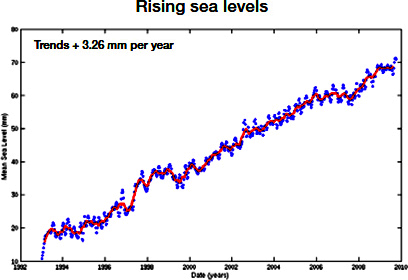
AN IMMENSE VIOLATION OF HUMAN RIGHTS?
Let’s imagine that a few thousand individuals decide on the fate of 7 billion others, without consulting them or worrying about their aspirations. It is not hard to conceive of the howls of indignation that such a situation would provoke. There would be talk of a flagrant violation of human rights. Yet is this not what we are doing now in deciding the fate of future generations?
This attitude is reflective of the narrow notion of altruism held by a certain number of us. They are concerned about the fate of their children and grandchildren, but it is difficult for them to think about future generations with the same sense of responsibility. Groucho Marx wonderfully illustrates this egocentric attitude with his famous quip: “Why should I care about future generations? What have they ever done for me?”
The point of view bound up in Groucho Marx’s joke is unfortunately taken seriously by many philosophers, who note that our relationship with future beings is one-way, since none of them will be in a position to pay us back or to punish us for our current actions. Norman Care, former professor at Oberlin College in Ohio, for example, asserts that we can have no bonds of love or anxiety for indefinite future persons: “their interests cannot interest us.”29 He is of the view that we have no community bond with the humans of tomorrow, nor any sense of belonging to a common enterprise or a common humanity. Conversely, other thinkers, such as the British philosopher Derek Parfit, do not share this highly individualistic opinion, and think that it is morally unjustifiable to attach greater importance to the present generation than to those of the future.30
DO FUTURE BEINGS HAVE RIGHTS?
It is undoubtedly tricky for us to picture these generations to come: in our minds, they are nothing but a multitude of vague people. Moreover, philosophers have questioned the moral status of beings who do not yet exist, above all by asking whether or not they can have rights. The question may seem strange since, however virtual and anonymous they may seem to us today, it is certain that an incalculable number of them will come into the world.
According to the philosopher Clare Palmer, with whom I discussed this issue, philosophers trip up here due to the fact that theories dealing with the rights of the individual were designed to resolve ethical issues among people living in our own time.31 Richard Degeorge, from the University of Kansas, is among those who consider that a future being can only have rights once they have come into the world.32
Ernest Partridge, an American philosopher specializing in environmental ethics, believes that this argument is valid for “active rights,” namely the rights to do something, but that “passive rights,” such as the right not to be denied the chance of living a healthy life, are entirely applicable to people in the future.33
In addition, many philosophers consider that rights and duties can only concern specific people, and that we do not have to feel responsible for the suffering or happiness of beings in general. To escape this impasse, all one needs to do, instead of arguing about “rights,” is to speak the language of altruism and compassion. If the extension of altruism to all our fellow beings is a faculty unique to the human species, then its extension to future generations is but a logical consequence.
Not knowing who these people will be takes nothing away from the fact that, like us, they will aspire to evade suffering and be happy. We therefore cannot exempt ourselves from asking about the consequences of our actions and our way of life. It is perfectly normal for us not to ransack the house that we intend to bequeath to our grandchildren. Why not grant the same attention to the future inhabitants of the planet? This is the view of Edith Brown Weiss, professor of international and environmental law at Georgetown University, who talks of the “principle of intergenerational equity,” which states that each generation leaves its successor a planet that is in at least as good a condition as that generation had inherited it.34
HOW ARE OUR CONTEMPORARIES REACTING?
According to research by Robert Kurzban and Daniel Houser, the former a psychologist at the University of Pennsylvania, the latter an economist, around 20% of people are altruists who bear the fortunes of future generations in mind and are disposed to altering their ways of consumption to avoid destroying the environment. Among them, some are motivated principally by respect for nature, while others are most preoccupied by human well-being, with yet more thinking that the two issues are one and the same.35
Around 60% of people follow prevailing trends and opinion leaders, something that highlights the power of the herd instinct in humans. These “followers” are also “conditional cooperators”: they are ready to contribute to the public good on the condition that everyone else does likewise.
The final 20% are not at all inclined to cooperate and want more than anything to take advantage of all the opportunities available to them. They are not opposed to other people’s happiness in principle, but it is not their business. They assert the right to be happy without any sense of duty or responsibility toward others in return. Preferring competition over cooperation, they are dedicated to promoting their own personal prosperity.
These deep-down individualists who act like lone rangers are sometimes described by the less charitable term “free riders,” by virtue of the fact that they seek to gain as much as possible from their fellow beings and from the planet, considered in both cases to be instruments of their own well-being. Feeling little responsibility toward their peers, they are even less worried about the people of tomorrow. Here we again see that libertarian attitude promulgated by followers of Ayn Rand, which boils down to “me, more me, and me again,” and we recall the words of the billionaire Steven Forbes about the expected rise in sea levels: “To change what we do because something is going to happen in one hundred years is, I would say, profoundly weird.”36 In other words, après moi le déluge…
ECOLOGICAL FOOTPRINT
The way of life of this individualist minority—often the most rich—is such that its ecological footprint is disproportionately large compared to the rest of the population. A person’s ecological footprint is defined as the area of land required to supply him with food and habitat, the energy required for his movements. These movements are linked to an individual’s consumption and waste management, as well as the emissions (greenhouse gases and pollutants) for which he is responsible. If one were to divide the total area of Earth’s biologically productive land by the number of its inhabitants, each person would have around 1.8 hectares. Yet the average ecological footprint is currently 2.7 hectares per person in the world, proof that we are living beyond our global means. These ecological footprints vary according to living standards: the average American’s is 8 hectares; it is 6 hectares in Sweden; 1.8 hectares in most parts of Africa; and 0.4 hectares in India.37 Stephen Pacala of Princeton University has calculated that the best-off, those who represent 7% of the global population, are responsible for half the world’s CO2 emissions, while the poorest 50% only emit 7%, a negligible amount for 3.5 billion people. The richest 7%, who moreover enjoy the best means for protecting themselves against pollution, benefit at the expense of the rest of the world.38
There certainly exist, among those with great fortunes, people who are generous and determined to strive for a better world, but they remain the minority. Today, the lifestyle of the wealthiest compromises the future prosperity of humanity and the well-being of the biosphere.
We must act, but it is not enough to economize by simply insulating our homes better, employing solar or geothermic energy, using appliances that consume less electricity, etc. It appears that people who make these kinds of savings often end up spending more money traveling, for example, or enjoying other activities and purchases that bring about—directly or indirectly—greenhouse gas emissions and various other forms of pollution. We must therefore not only save energy, but also live more modestly and stop associating moderation with dissatisfaction.39
Some countries have succeeded in meeting this challenge. Japan, for example, consumes half as much energy per capita than European Union countries, and three times less than the United States. This is due to the fact that it has to import a great deal of its energy, making it more expensive. High energy prices have had a salutary effect on consumption, without doing any harm to the country’s prosperity or competitiveness at the international level. To the contrary, these limitations have stimulated innovation and the development of businesses that are less energy-intensive, particularly in the field of new technology.40
CLOSE COLLABORATION BETWEEN SCIENCE AND GOVERNMENT IS ESSENTIAL
According to recent findings, limiting global warming to 2°C would appear to require an 80% reduction in CO2 emissions between now and 2050. The public’s willingness to do what is necessary to meet this objective remains very weak, particularly at times of recession, while leaders think of nothing but stimulating consumption.41 Scientists, who produce the most reliable data, are regarded more often as spoilsports rather than holders of the knowledge needed to lead to the best decision-making.42 Those in power never stop negotiating compromises, which are inherently harmful since they are less effective than the solutions being recommended. It’s the equivalent of a severely ill person asking his doctor for permission to take only half the dosage of the medication required for his recovery.
For thirty years now, governments have signed over 500 international agreements to protect the environment. But, with the exception of the Montreal Protocol in 1987, which led to efficient measures to slow down the depletion of the ozone layer, most of these have been relatively ineffectual because of a lack of coordination, political will, and, above all, the absence of sanctions for those contravening the terms of the agreements.
In his book Collapse: How Societies Choose to Fail or Succeed, Jared Diamond calculated that the billion inhabitants living in rich countries enjoy thirty-two times more resources per person than the other 6 billion in the world.43 If this 6 billion consumed as much as the wealthier billion, we would need three planets to provide for their needs. To look at China alone, where the income per capita is still just a tenth of that of the average American, the planet’s demand for natural resources would double. Or if China had the same number of cars per person as the United States, it would use up the world’s entire petrol production.44 Yet China is moving in that direction. The situation therefore simply isn’t tenable.
It is high time we established an atmosphere of trust between scientists, decision-makers, economists, business, and the media so that the latter parties listen to and understand the scientific consensus and realize that they are working toward a common purpose in a spirit of cooperation and solidarity. As H. G. Wells said: “history is a race between education and catastrophe.”
Contemporary society is built on the myth of unlimited growth that very few economists and politicians are willing to question. No previous generation has mortgaged the future to this extent. These debts will be repaid in the form of ecological disasters when we have overstepped our planet’s safe boundaries. At the start, those countries that have contributed the least in terms of wastage will suffer more than others, but ultimately no one will be spared. As Martin Luther King Jr. said: “We may have all come on different ships, but we’re in the same boat now.”
FEEDING 9 BILLION HUMANS
The human population will continue to grow until about 2050, probably stabilizing at around the 9 billion mark. This growth will take place predominantly in poorer countries.45 By consequence, food production will have to increase by 70% between now and 2050. Lifting 1 billion human beings out of poverty and feeding 2 or 3 more billion constitutes an enormous challenge, made all the more acute by the weakening of the ecosystem occasioned by the production of the additional food required. Indeed the expansion of agriculture and livestock farming contributes greatly to crossing five of the nine planetary boundaries required to safeguard humanity.46 It is therefore essential to implement measures for producing more food for human beings without further depleting our ecosystems.
Agriculture alone accounts for as much as 17% of greenhouse gas emissions. According to a Food and Agriculture Organization (FAO) report, in all the world’s tropical areas, harvest yields could fall by between 25% and 50% in the next fifty years, due to a decrease in annual rainfall.47 The warming will lead to a temporary increase in agricultural production in temperate areas, but this increase soon risks being compromised by the proliferation of diseases and parasites that threaten harvests.
However, according to the “Agroecology and the Right to Food” report published in 2011 by Olivier De Schutter, who was the United Nations Special Rapporteur on the Right to Food from 2007 to 2014, agroecology could double the food production of entire regions in ten years’ time while simultaneously reducing poverty in rural areas and providing solutions to climate change. This Belgian law professor’s proposals could transform the international trade system that has been built up by the World Trade Organization (WTO) since the Second World War.48
For those who argue that agricultural production would plummet by 40% if we were to abolish pesticides, preventing us from feeding the world, De Schutter’s response is as follows: “These figures suppose that we would not compensate for the rejection of pesticides by improving our production techniques, for example with the biological control methods promoted by agroecology.… In addition, agroecology lowers production costs, since it reduces the use of pesticides and chemical fertilizers. The price of these products has risen faster in the last four or five years than the price of the foodstuffs themselves. Agroecology is particularly beneficial to small producers in developing countries wishing to operate at low cost.”49
Agroecology is a cutting-edge science that combines ecology, biology, and traditional knowledge. Research in this field is not yet sufficiently developed since it is not patentable, so is still relatively unattractive to big business. It also suffers from people’s inability to consider agricultural modernization from any point of view other than increased mechanization and industrialization.
THE INJUSTICE OF ENVIRONMENTAL CHANGE
I met Jonathan Patz for the first time with our mutual friend the neuroscientist Richard Davidson in a small Nepalese restaurant in Madison, Wisconsin. Jonathan arrived by bicycle, the simplicity of his appearance belying his status as a preeminent academic. He is now director of the Global Health Institute at the University of Wisconsin–Madison, and one of the main authors of the reports published by the UN’s Intergovernmental Panel on Climate Change, the co-winner of the Nobel Peace Prize with Al Gore in 2007. He has specialized in, among other things, the study of the health effects of environmental change.
He explained to us why global environmental change is at the source of one of the most serious ethical crises of our time, namely the unequal manner in which this change affects populations. This inequality exists between nations (poor countries suffering much more than the richest), generations (future generations will be more affected than the current one), species (some will be endangered to the point of extinction), and social classes within a single country (once again, the most disadvantaged will suffer more than the rich; children and the elderly more than the middle-aged; and those living on the street more than those in housing).50
Regions that are already experiencing the serious consequences, and will go on to suffer the worst effects, of global warming and other major changes to our ecosystems bear the least responsibility for this change. Jonathan showed us two maps of the world. On the first, the size of the countries is proportionate to their share of responsibility for global CO2 emissions into the atmosphere. We can see that the rich northern hemisphere countries (the United States, Europe, Russia) are swollen like balloons, while Africa practically disappears off the map. On the second one, the size of the countries represents the number of deaths caused by recent spikes in temperature and other phenomena linked with climate change. This time, it is the rich countries that become virtually invisible, while Africa and India invade the globe.51 The risk of climate-related disease will have more than doubled by 2030.52 In short, those who suffer from these calamities are not those who have caused them.

It is also these countries that will suffer disproportionately from the rise of several diseases whose incidence rates vary with climate. According to the WHO, 88% of disease attributable to climate change affects children below the age of five. This involves several diseases, including malaria, dengue fever, yellow fever, cholera, diarrhea, river blindness (onchocerciasis), leishmaniasis, Lyme disease, and respiratory diseases, especially asthma. Each year, 800,000 deaths are caused by air pollution in urban areas.53
In addition, people’s health will also be affected by malnutrition, forced migration, and conflict—all the result of climate change. According to Jonathan, all the information currently available points to the conclusion that 23% of all deaths—36% among children—are linked to environmental factors influenced by human activity. He cited one striking example: during the Olympic Games in Atlanta in 1996, the organizers restricted the use of cars. One of the consequences of this was that morning rush-hour traffic fell by 23%, and peak ozone levels by 28%. At the same time the number of emergency hospital visits related to asthma in children plummeted by an astonishing 42%.
Conversely, during the warming triggered by the 1997 and 1998 El Niño weather phenomenon, winter temperatures in Lima were 5°C above average, and the number of hospital admissions for acute diarrhea increased by 200% compared with the five previous years.54
Malaria kills between 1 and 3 million people worldwide each year, the majority children living in developing countries. As it happens, the transmission of malaria is strongly affected by climate. The time it takes for the parasite to develop inside a mosquito is closely linked to temperature. It can be thirty days if the atmospheric temperature is around 18°C, but just ten days if it is 30°C. What’s more, the relationship is not linear: in hot regions, an increase of 0.5°C in temperature can translate into a rise of 30% to 100% in the number of mosquitoes.
Similarly, the incidence rate of malaria is greatly intensified by deforestation. It has been shown that deforestation in the Amazon basin increases the size of the habitat favorable to the reproduction of the Anopheles darlingi mosquito, the principal malaria vector in the region. The “bite rate” in deforested areas of the Peruvian Amazon is nearly three hundred times higher than in regions where the forest is intact (taking into account differences in human population density in these differing biotopes).55 Several studies have also highlighted the correlation between deforestation and increased exposure to malaria in sub-Saharan Africa.56
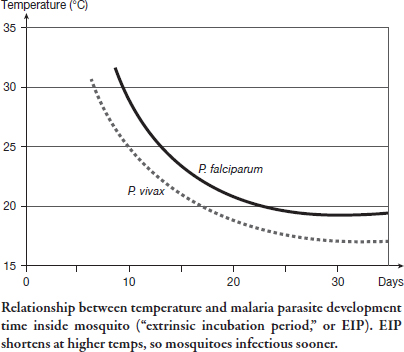
In addition, as the economist Jeffrey Sachs has underlined, there is a clear correlation between the prevalence of malaria and poverty: the poorer a population, the less capable it is of protecting itself against malaria; and the more people are affected by malaria, the less prosperous their economy becomes.57 The GDP in African countries where malaria is endemic grows by an average of 0.4% per annum, versus 2.3% in countries that are relatively little affected by the disease.
Prompted by the former investor and philanthropist Ray Chambers, now the UN’s Special Envoy for Malaria, an ambitious program has been launched in the seven worst affected African countries. Ray and his team have succeeded in raising 6 billion dollars and have distributed 300 million mosquito nets treated with insecticide, bringing protection to 800 million people. This project has already saved the lives of more than 1 million people. The end of 2013 result of approximately 437,000 child deaths from malaria in Africa represents an almost 60% decrease in the mortality rate since this collective fight against malaria began seven years ago. With the expected progress during 2015, a path to reaching the target of fewer than 100,000 child deaths from malaria is now clear.58 Yet, all these efforts could be compromised in the medium term by global warming if the latter is not contained below 2°C.
A REVEALING EXAMPLE OF INTERDEPENDENCE
In conclusion, Jonathan Patz told us this story, which illustrates the extent to which all aspects of the environment are closely interdependent. In the 1950s, the WHO launched a malaria control program in Borneo, using large quantities of dieldrin. The program seemed to be working effectively since the mosquitoes were largely eradicated. But one or two years later, a typhus fever epidemic broke out; and at the same time, all the straw roofs in the villages collapsed. Why?
Dieldrin had indeed killed the mosquitoes, along with all the flies and cockroaches. But that wasn’t all. The geckos that feed on the insects in the houses had acquired high levels of dieldrin in their body fat. The cats, who ate the geckos, had all died from that. In the absence of the cats, the rat population had exploded, and with it, the number of typhus-carrying fleas that parasitized the rats. The fleas transmitted the disease to the humans. Already the first catastrophe was under way, but why did the roofs cave in? The dieldrin had not just killed the mosquitos, flies, and cockroaches. It had also virtually wiped out a species of wasp that normally kills a certain type of caterpillar in order to lay its eggs, allowing the incoming larvae to feed off the caterpillar’s body. As a result of the decline of the wasp population, the caterpillars had proliferated in the straw roofs, which had disintegrated and then collapsed. This example perfectly illustrates the incredible richness and subtlety of the levels of interdependence that link all Nature’s dynamic agents and forces. It also cautions us to take far greater care of the natural equilibrium that has been in place for millennia.
PESSIMISM IS A WASTE OF TIME: SOLUTIONS EXIST
As the photographer and environmentalist Yann Arthus-Bertrand rightly said, if we want to preserve the well-being of our biosphere, “it’s too late to be a pessimist.”59 Wijkmann and Rockström give two good reasons for optimism: the potential of replacing all fossil fuel energy with renewable energy by 2050; and the dawn of a “triply green” agricultural revolution, which is also quite possible.
The German Advisory Council on Global Change (Wissenschaftlicher Beirat der Bundesregierung Globale Umweltvervänderungen, or WGBU) devised a plan to place a limit on the use of fossil fuels—oil, coal, and natural gas—between now and 2050, at the same time as meeting global energy demand. On top of promoting renewable energy, one of the key points in this plan relates to the overall use of vehicles running off hydrogen, methane, gas, electricity, etc.60
Implementing such a program of course depends on world leaders rallying to the cause: this plan will require global investment to the tune of 1 billion dollars per year, and will only be profitable in the long term. This massive investment is far from unachievable, since worldwide government subsidies directed at keeping the price of oil at a level below its real cost already represent 400 to 500 billion dollars each year. These subsidies prolong oil and gas consumption, and hinder the technological development of renewable energy sources, which has in the same time period only received subsidies worth 66 billion dollars.61
The G20 has now committed to bringing an end to subsidies for fossil fuels, whose usage will decrease as renewable energy sources are made available in poorer countries, so as not to handicap these nations with punitively high rises in energy prices.
We have another reason to be optimistic. In contrast to other irremediable forms of environmental degradation (the loss of animal and plant species in particular), global warming is to an extent reversible: it is possible to cool the atmosphere by capturing enough CO2. A 2010 report by McKinsey & Company shows that a 40% reduction in greenhouse gas emissions is possible by 2030, thanks to technological advances that would, in addition, lead to savings.62
The European Climate Foundation, or ECF, has published a report entitled Roadmap 2050, which shows that it is entirely possible to reduce CO2 by 80% to 95% by 2050, provided that 80% of electricity is generated from renewable sources. What’s more, this report convincingly shows that—over time—energy costs would overall become lower than those of energy from fossil fuels.
As far as Rockström and his colleagues are concerned, there is no doubt whatsoever that a tax of 50 to 180 dollars per ton of CO2 emitted would provide the greatest incentive to speed up the transition to renewable energy. The tax currently applied by the European Union is just 20 dollars per ton, which is inadequate in the eyes of the scientific community. The example of Sweden is revealing. There they have imposed a tax of 100 dollars per ton, which has virtually eliminated the use of hydrocarbons in heating and significantly reduced industrial CO2 emissions without doing anything to harm national economic growth. In Germany, new feed-in electricity tariffs have brought about a remarkable rise in renewable energy, particularly wind and solar, which now represents 10% of the country’s production. In China, the solar energy sector will multiply by a factor of ten by 2015. According to a report by the Climate Commission in Australia, in 2012 China reduced its growth in electricity demand by a half. Considerable progress has also been made in Spain and Scandinavia. Jeremy Rifkin, president of the Foundation on Economic Trends, has stated that in 2009 the European Union installed more wind energy than any other energy source: 38% of all new energy deployment. The sector, which currently employs almost 200,000 people across the EU and produces 4.8% of its electricity, could supply—according to estimates—almost 17% of electricity in the European market in 2020, and 35% in 2030. By then it will employ nearly half a million people.63 The time has come to roll out this transition across the world.
The cost required to curb greenhouse gas emissions, protect the tropical rainforest, and stabilize the world’s climate has been estimated at around 150 to 200 billion dollars per year. This is certainly an enormous sum, but if we consider that each year 400 billion dollars are spent on advertising and that the Iraq war cost the United States 3 trillion dollars,64 it becomes abundantly clear that businesses and governments are willing to spend colossal sums on things that are either insignificant or destructive.
There are various ways to raise this sum each year—it just requires the necessary political will. A tax of one dollar per barrel of oil, for example, would bring in 30 billion dollars per year, which is not excessive considering that the use of oil is, directly or indirectly, the principal cause of climate change.
Restoring and preserving Earth’s ecosystems involves short-term spending, but represents an excellent long-term investment. For example, in the case of the tropical rainforest, the cost of restoration is estimated at 3,450 dollars per hectare, with profits from the restoration reaching 1,620 dollars, i.e. an internal rate of return of 50%. This dividend is 20% for other types of forest, 27% for lakes and rivers, 7% for coral reefs, 12% for marshland, and 79% for grassland.65
According to Rockström, companies in the financial, industrial, and banking sectors should produce a balance sheet that includes their environmental impact, and adapt their staff training methods to include education on the environmental effects of their activity.
THE CRUCIAL HYDROCARBON ALTERNATIVE
We have seen that 78% of CO2 emissions come from the use of fossil fuels. The production of hydrocarbons has multiplied by a factor of ten since 1950. Agriculture too has become increasingly dependent on energy from fossil fuels: calculations carried out in the United States show that 7 to 8 fossil fuel calories are needed for the production of every calorie of food consumed. Today feeding the average American for a year requires 1.6 tons of hydrocarbons.
Until now, economic growth in the richest countries has gone hand in hand with the growth of hydrocarbon consumption.66 But the age of cheap oil is past. Every year, we consume twice as much oil as we discover, hence the deplorable idea of resorting to the exploitation of shale gas. Different studies by several independent groups have shown that the maximum level of hydrocarbon production will have been reached by 2018, after which we will experience a period of constant price hikes.67 Most of the focus has been on the exploitation of existing resources and the search for new deposits, an approach which merely pushes back the inevitable deadline. Governments have delayed majorly in terms of creating any alternative solutions.
If we were to succeed in generating almost all of the energy we need from renewable sources, we would have already resolved the best part of the climate challenge. The beauty of energy management, as Rockström remarks, lies in the fact that, once produced, both forms of energy are entirely interchangeable: electricity from coal is exactly the same as electricity produced using wind power.68
A COMPLETE TRANSITION TOWARD RENEWABLE ENERGY
There is no doubt that renewable energy can comfortably cater to global demand, which currently stands at around 500 exajoules (EJ): the production potential of wind energy is greater than 1000 EJ, and if we factor in the potential of geothermic, solar, and hydroelectric power, the figure is as great as 11,000 EJ.69
The DESERTEC project, which saw the light of day in Germany, aims to install a new system for capturing solar energy in the Sahara desert. During the day, the sun’s rays can heat oil reservoirs to temperatures of 1,300°C, with the resulting heat producing vapor that in turn drives electricity-generating turbines. The oil cools relatively slowly, and the heat stored during the day is capable of guaranteeing overnight electricity production through the following morning. An area of just 10km2 of panels in the Sahara would be enough to supply electricity to North Africa and almost the whole of Europe (via ultra-efficient underwater cables). DESERTEC has already launched pilot projects in Morocco, Tunisia, and Egypt. The technology can be rolled out to any desert in the world, from the center of Spain to Australia via the Gobi Desert. According to another study carried out in Japan, if photovoltaic panels were installed on 4% of the world’s total desert area, they would produce energy levels equivalent to global energy consumption.70
In 2009, for the first time in Europe, investment in wind and solar energy production overtook investment in conventional electricity production. Overall, renewable energy still only represents a tiny percentage of the energy produced in the world, but even so production is growing by 20% every year. The challenge then is to take renewable energy from where it sits at 2% to 3% and to get it up to 80% or even 100% by 2050.71
Residential and commercial buildings currently consume 40% of all energy produced, and they are the main contributors to greenhouse gas emissions. Nowadays it is possible to use “passive energy,” and even to fit out buildings in such a way that they produce electricity that can be fed back into the grid.
SUPPLYING ENERGY TO POOR COUNTRIES
In the meantime, poorer countries are suffering from chronic energy shortages. In Africa, 85% of the population have no access to electricity. The same goes for 60% of the population of South Asia. Supplying safe, renewable energy to the Third World is essential for alleviating poverty and improving the health of disadvantaged peoples. Better access to renewable energy would also allow schools, medical clinics, and village community buildings to function more efficiently. In Bangladesh, for example, thanks to a program run by Muhammad Yunus’s organization Grameen Solar, in 2010 one million people received electricity generated using solar panels. Mass production of solar energy has also led to a considerable fall in electricity prices. Improving people’s access to energy sources in poor countries now represents one of the United Nations’ main priorities, their objective being to guarantee global energy supply by 2030.72
More than a million and a half people die each year from household pollution resulting from the burning of wood, coal, and dried dung inside the home, and from oil or kerosene lighting. The use of electricity and solar cooking equipment, which involves large, cheap, round dishes for boiling water and cooking food, would stamp out these health and accident risks.
SENSIBLE WATER MANAGEMENT
It is absolutely essential that we manage our freshwater reserves more rationally. Today, 70% of the freshwater we use comes from dwindling lakes, rivers, and water tables. One-quarter of the world’s watercourses no longer reach the ocean, overexploited as they are for agricultural purposes. And the situation is only getting worse.
We have already seen that 70% of world freshwater extraction is dedicated to agriculture. Nothing consumes more water than food production, especially meat (lest we forget, the production of 1kg of meat uses up fifty times more water than for 1kg of cereals). Across the world, the amount of water required each day to produce enough food for one person—taking every phase into account—is 3,000–4,000 liters, an astonishingly high figure, while 50 to 150 liters covers our other basic daily needs, such as drinking, washing, and cleaning our houses and clothes.
Two improvements are necessary: collecting more rainwater, and making better use of “green” water. If we refer to water from rivers, lakes, and the water table as “blue” water, “green” water is the invisible water that maintains the dampness of the soil, is found inside plants, evaporates following transpiration, and is released back into the atmosphere. More than 60% of the water that makes up the hydrological cycle is “green” water.73 It is responsible for making plants grow, and facilitates freshwater-dependent agriculture, which represents 80% of world farming. The best opportunities for improving agricultural practice rest here.
In developing countries, especially South Asia, it is possible to restore water-table levels and resupply exhausted wells in villages by building rainwater dikes, which let the water filter down into the soil rather than evaporate away quickly. What’s more, collecting rainwater on the roofs of houses and storing it in large underground cisterns, built using traditional materials, is enough to ensure a plentiful supply in villages that up until now have suffered terrible freshwater shortages. These techniques have been implemented, for instance, in the arid regions of Rajasthan, India, by Bunker Roy’s Barefoot College.
FOOD FOR ALL WITHOUT DESTROYING THE BIOSPHERE: A REAL GREEN REVOLUTION
Some 40% of Earth’s land area is dedicated to agriculture. Agriculture and livestock farming are responsible for 30% of greenhouse gas emissions, and are the principal cause of nitrogen and phosphorous being released into the atmosphere. Several scientific reports present new methods that would lead to producing enough food at the same time as avoiding the destruction of the environment.74
An executive summary, published by the FAO in 2011, shows that it is possible to produce 70% more food in the world without increasing the area of cultivated land.75 However, this report emphasizes that growth in production must not come about by resorting to intensive farming methods using chemical fertilizers and pesticides.
According to Wijkmann and Rockström, we require nothing short of a “triply green” revolution. The first green revolution, which occurred in the 1960s, more than doubled our cereal crop production, mainly rice, maize, and wheat. India in particular witnessed a spectacular increase in food resources. But this initial revolution relied heavily on mass use of chemical fertilizers, pesticides, hybrid seeds, and irrigation methods that required diesel pumps to extract water from very deep in the soil.
The long-term consequences of this temporary increase in production were detrimental in several ways: exhausting water tables, soil erosion and impoverishment, chemical pollution, and negative social impacts in rural communities where people’s lifestyles were profoundly changed. In her prophetic book Silent Spring, Rachel Carson posed the question: “Can anyone believe it is possible to lay down such a barrage of poisons on the surface of the earth without making it unfit for all life?”76
We talk about “insecticides,” but more apt would be the term “biocides.” Agroecologists the world over possess an increasing amount of evidence to show that organic farming can produce roughly the same amount of food as “chemical” farming. This can be achieved by creating a balance between agriculture and livestock farming, which produces natural fertilizer; promoting crop rotation, which allows the soil to regain its levels of organic nitrogen; and avoiding intensive plowing, thus protecting soil quality. Nitrogen loss in the soil is reduced by 30% if farmers grow cover crops in the winter, such as rye or wheat, which also increase carbon capture in the soil.
According to the Stockholm Environment Institute and the Stockholm Resilience Center headed up by Rockström, the next agricultural revolution must add two green revolutions to the first. On the one hand we must gradually move away from the use of chemical fertilizers and pesticides, and on the other, use “green” water from renewable sources so as not to exhaust lakes, rivers, and water tables.
A summary of all these potential outcomes, presented in Jonathan Foley’s article “Solutions for a cultivated planet,”77 which was published in the journal Nature, shows that it is possible to feed 9 billion human beings in a way that does not destroy the land still available to us, especially in tropical regions. The authors also stress the importance of reducing wastage at every stage of the food production process: 30% of the food bought in rich countries ends up in the trash (the same applies to medicine). Almost 50% of the food produced in the world never reaches a human stomach for reasons as varied as insufficient infrastructure and storage facilities, overly strict regulations regarding expiry dates, “buy one get one free”–type offers, and the habit among consumers of only selecting food with a perfect appearance.
REVITALIZING THE SOIL
One of the most strongly recommended measures is to stop deep plowing, which exposes the richest elements of the soil to the air: the organic matter heats up in the sun, dries and evaporates, emitting CO2 and leading to a major depletion of carbon levels. The soil’s microfauna—bacteria, acari, earthworms, and other life-giving organisms—is destroyed and erosion becomes more serious. Earth sterilized by plowing also becomes harder and more compact, preventing plants’ roots from reaching deeper water. The soil therefore becomes less and less fertile and its yield decreases. Land should therefore only be worked as minimally as possible on the surface, or even not at all: in Uruguay, Paraguay, and Bolivia, in the last ten to fifteen years, 70% of farmers have stopped plowing their fields and in doing so their yields have returned to their highest levels.
These techniques also allow a soft approach to sowing that avoids turning the soil over. They have the advantage of considerably reducing soil erosion and work time (and therefore energy consumption), improving soil structure, bearing capacity, and porosity (making it easier for water to filter through), and enhancing the biological richness of the earth.
In the 1980s in Burkina Faso, the agroecologist Pierre Rabhi showed that it was possible to reverse the desertification process with methods that were easily adoptable for local communities. These techniques involve: revitalizing dry soil with natural compost (humus), which is rich in microorganisms and capable of holding up to five times its weight in water; planting trees; building low stone walls to slow down water run-off; and reintroducing traditional, more durable seeds.78 These very techniques were implemented by Yacouba Sawadogo, a humble farmer, who has over the course of the last thirty years succeeded in revegetating 6 million hectares in the Sahel region, earning the respect of all the nation’s farmers and of big international organizations. Water table levels have risen in these areas, trees are making the landscape greener, and cereal crop harvests have become plentiful.79
As we saw in the chapter headed “Individualized Selfishness,” the Indian NGO Navdanya operates in sixteen Indian states distributing seeds, including no fewer than 600 varieties of rice and 150 varieties of wheat, to farmers seeking to practice organic farming and reestablish their food self-sufficiency.80 At present, Navdanya counts half a million farmers among its membership.
ESTABLISHING A CIRCULAR ECONOMY BY RECYCLING ALL RARE METALS
Despite various worthy efforts, raw material recycling rates remain extremely poor. According to a 2011 report by the United Nations Environment Programme (UNEP), the transition to a green economy requires a huge step forward from feeble current levels of metal recycling. Just twenty of the sixty metals taken into consideration are recycled at more than a rate of 50%, and for thirty-four of the other forty metals it is lower than 1%, even though many of them play a crucial role in various clean technological devices, such as batteries for hybrid cars or wind turbine magnets.85 Yet in theory, metals can be recycled an infinite number of times, and this process would create new job opportunities.
By recycling aluminum instead of making it from bauxite, CO2 emissions created in its production could be reduced by 90%. Nowadays, however, just a third of aluminum comes from recycling. In addition, if one were to recycle lead instead of processing it from minerals, the corresponding CO2 emissions would decrease by 99%. The same applies for iron, copper, nickel, tin, and other metals. Moreover, 50 million tons of electronics are thrown away each year, with only 15% to 20% recycled.86
What’s more, rare metal deposits are dwindling very quickly. According to one evaluation of the reserves of eighteen rare metals used in key industrial sectors, six will be exhausted in the next fifty years at the current rate of consumption, and thirteen in the same timeframe if the whole world were to use just half the amount consumed by the United States.87 Ever heard of indium? This element is much in demand for the manufacture of flat-screens used in computers and televisions. It is the most endangered of the eighteen rare metals and, at the current rate of consumption, it will have been exhausted in the next thirteen years. It multiplied in price by a factor of ten between 2006 and 2009. The price of tantalum, used to make mobile telephones, has also increased significantly, and the desire to control its exploitation is one of the main causes of the bloody civil war in Congo.
At this rate—if demand does not increase, which seems unlikely—zinc will be exhausted in the next forty-six years, tin in forty, silver in twenty-nine, and copper in sixty-one. Only aluminum (1,027 years), platinum (360), and chromium (143) are still relatively abundant.
AN INTELLIGENT NETWORK FOR SHARING RENEWABLE ENERGY
In The Third Industrial Revolution,88 the economist Jeremy Rifkin proposes that all buildings should be transformed into miniature local power plants operating on geothermal, wind, and solar power, and by converting waste. If millions of buildings were to generate renewable energy, store any surplus by turning it into hydrogen (which can then at any moment be reconverted into electricity), or sell it on to millions of other users, the resulting power would far exceed the production capacity of national power plants, whether they are nuclear, coal-fired, or gas. The process would involve producing hydrogen by the simple electrolysis of water using solar electricity, while another system would recombine it with oxygen in a fuel cell to produce electricity on demand. This process has the major advantage of being entirely clean, and, unlike batteries, doesn’t use any polluting elements such as cadmium or lithium.
A computerized system would enable the distribution of any excess into areas that do not have electricity at any given moment because of disruptions in production, and supply charging stations for hydrogen-powered cars. Experimental buses and hydrogen-powered vehicles are already in use in Europe. In May 2007, the European Parliament, the legislative body representing the then twenty-seven European Union member states, voted to commit to supporting this third industrial revolution.89 Several pilot projects have been put in place, notably in Corsica, where a large field of photovoltaic panels have been installed near Ajaccio, along with an almost industrial-scale system for the production and storage of hydrogen, designed to compensate for the inevitable interruptions associated with solar power.
SOME ENCOURAGING SIGNS
Some countries have made laudable efforts in the area of environmental protection. Despite its rapid modernization, Vietnam, for example, has succeeded in increasing its forestry areas from representing 28% of the country’s area to 38% between the years 1990 and 2005, thanks to a systematic reforestation program (which is in stark contrast to the savage deforestation carried out in nearby Indonesia). Its rate of reforestation between 1970 and 1980 was twice as fast as the rate of deforestation.90 In Costa Rica, more than 95% of the country’s energy comes from renewable sources. In the Himalayas, Bhutan, a country roughly the size of Switzerland, captures four times more CO2 than it emits.
The United Nations’ biodiversity summit at Nagoya in 2010 resulted in a consensus among world governments to widen the area of biologically protected zones in the world. Some 17% of land area and 10% of the oceans were designated as natural reserves. At a second summit, in Hyderabad, India, in October 2012, signatories of the Convention on Biological Diversity (CBD) elected to double the spending made by developed countries (10 billion dollars) toward developing countries by 2015, so as to implement the plan to save the world’s “living systems” and the twenty-point strategy adopted in Nagoya for the period 2010–2020. The plan to protect international waters was quickly approved, and “marine areas of biological or ecological interest” were designated in the southwest Pacific, the Caribbean, the midwest Atlantic, and the Mediterranean.
Another initiative is that of “ethical markets” that use “green transition scorecards” (GTS) and track the private sector’s investment development in “green markets.” The report published by this organization in 2012 gives the sum of 3.3 trillion dollars of turnover in these markets since 2007.91
GREEN CITIES SET THE EXAMPLE
The city of Portland, Oregon, has topped the rankings year after year of America’s best cities to live in. In the 1970s, Tom McCall, the state’s first eco-minded governor, ripped up the freeway that bisected the city and transformed it into a 4,000-hectare public green space. His successors have continued his initiative. Between 1990 and 2008, the city reduced its CO2 emissions by 19%. As much as 26% of its total area is planted with trees, and counting (it will be 30% by 2030). This city of 1.4 million inhabitants has built 700 kilometers of cycle lanes, and employees at most companies who walk or cycle to work receive an extra 50 dollars in their monthly salary. A deposit is charged on all glass bottles to encourage recycling, and most fast-food chains (McDonald’s, Starbucks, etc.) have shut up shop to give way to restaurants serving local produce. Portland is the only American city where the construction of a Walmart, the world’s biggest supermarket, has been blocked by residents.92
Stockholm, with a population of 1 million, is another model green city. Some 70% of the city’s heating comes from renewable energy sources. It has set itself the target of moving away from all fossil fuels by 2050.93 Currently 95% of Stockholm’s population lives less than three hundred meters from a green space. Many of the city’s green zones actively contribute to water purification, noise reduction, biological diversity, and citizen well-being.
Most of the people in Stockholm use non-polluting public transport. The creation of a city toll following a 2007 referendum has considerably reduced traffic and, by consequence, air pollution. As such, since 1990, greenhouse gas emissions have fallen by 25%. The Swedish capital has also implemented an innovative waste management system that has guaranteed better rates of recycling.
An eco-neighborhood in Hamburg is to be heated via a cogeneration system: it will use solar and photovoltaic power as well as collect rainwater.
The Covenant of Mayors is an association bringing together European cities engaged in improving their energy efficiency and increasing the amount of renewable energy they use. The Covenant’s signatories aim to achieve, or even overtake, the European Union’s target to reduce CO2 emissions by 20% before 2020. More than four thousand European cities have agreed to meet these obligations.
Masdar, a city near Abu Dhabi that’s been under construction since 2008, will run exclusively on renewable energy, including solar power, a reliable resource given its desert location. It is meant to be completed this year, in 2015, and will have 50,000 inhabitants. The aim is for it to have zero CO2 emissions and to create no waste, and there will not be any cars. Not bad for the oil capital of the world!
To the north of Shanghai, China, a planned green city called Dongtan will also operate exclusively on renewable energy, and should start off with a population of 50,000 to 80,000, increasing to 500,000 in 2050.
Another example is BedZED (Beddington Zero Emissions Development),94 a neighborhood of eco-friendly buildings in the Hackbridge area of London, which is a carbon-positive development that produces more energy than it consumes.
TAKING ACTION AND NOT LOOKING FOR EXCUSES FOR DOING NOTHING
The progress required to relieve these environmental challenges is naturally fraught with obstacles, ranging from inertia to denial via compromise and a “wait-and-see” attitude.
First of all there are the climate-change deniers, who refuse to accept either that it is happening or that it is caused by humans. They are becoming more and more unreasonable and absurd even when the scientific data detailing changes to our biosphere mount up in front of us. Indeed, there is easily enough scientific data available to justify determined, sustained action if we are to avoid succumbing to what my father, Jean-François Revel, called “useless knowledge.”
After them we have the skeptical camp, who declare that decades of warnings about impending disaster have produced nothing of the sort. In 1880, for example, a scientist announced that the streets of Paris would be engulfed in a layer of manure due to the ever increasing number of horses in the capital. But these skeptics who claim to have seen it all will soon realize that these are not merely alarmist proclamations about localized problems, as with industrial pollution in nineteenth-century London, which made the air almost impossible to breathe, and turned the Thames into a putrid cesspit, but rather transformations that are largely irreversible.
It is true that the increase in disquieting news about climate change, the loss of biodiversity, and other serious environmental challenges can create a blasé attitude among some people or, conversely, elicit a feeling of powerlessness about the scale of the transformations and interventions required to overcome the problem. Everyone is sad that the bee population is in full decline, that fish stocks have decreased by 90%, or that only 10% of the forest we had ten thousand years ago remains. “What a shame!” we think, reassuring ourselves by saying, “Oh well, we’ll think of something…” Sunita Narain, director of the Centre for Science and Environment in New Delhi, sums up the attitude of our times with the mantra: “Don’t worry, just consume!”95
In the past, local communities have of course successfully overcome lots of similar difficulties, but the problem we face today is entirely different: it is the first time in human history that our species is associated with such rapid and radical planetary change.
Then there are the relativists, such as the Danish statistician Bjorn Lomborg, who think that there are other problems, such as poverty, dwindling food reserves, AIDS, and other contagious diseases, that require greater resources and need fixing more urgently than climate change, which he deems to be unconfirmed anyway.96 Here we see a twofold error of judgment, since not only is climate change now an undeniable fact, but also, as we have seen time and again, it is precisely the world’s poorest people who will suffer the most from diseases whose contagiousness increases the hotter the temperature gets, and that the dwindling of food resources is also made worse by climate change. Human well-being therefore goes hand in hand with the fight against climate change.
To say that the well-being of the current generation of humans is more important than the next is like saying that it is more useful to make your house comfortable instead of extinguishing the approaching fire that is threatening to destroy the entire village.
Next on the list are the opportunists, who are disturbed by the idea of prosperity without growth. They would rather maximize growth that benefits the current generation as much as possible. They also see economic opportunities in the melting of the arctic (to exploit oil reserves deep below the North Pole) and eagerly anticipate Siberia becoming the new Riviera for vacationers. In order to do nothing to protect the environment right now, they praise in advance the ingenuity of future generations, who will, they tell us, figure out the solutions. This is not to underestimate the human species’ creativity and capacity for innovation, but we must be clear-sighted, and the existence of critical boundaries in a variety of fields will make the task impossible. Today we are, in various places, trying to reintroduce species that have disappeared from them—wolves, Tasmanian devils, and, in parts of Western Europe, bears, lynxes, and vultures—but these frequently unsuccessful cosmetic changes will be eclipsed by the anticipated disappearance of 30% of living species by 2050.
A QUESTION OF COMMON SENSE
The planet is not a fixed entity and never will be. Countless species appeared and became extinct well before Homo sapiens arrived on the scene. There is no way, therefore, that we can conceive of an “ideal state” for a planet that is constantly evolving. But a major change has come about—we have entered the period that most scientists have agreed to call the Anthropocene, an epoch in which humans have become a geological force that profoundly alters the natural equilibrium and is significant enough to threaten both the well-being of humankind and the survival of innumerable other species.
In conclusion, it is an urgent imperative that we recognize the links between humans and nature, our economies and the biggest transformations affecting our planet. In other words, we must be more aware than ever of our place in the biosphere. As we approach the boundaries of what Earth can offer us and tolerate, we must realize that our future well-being depends on our capacity to remain within these planetary boundaries. The report entitled “Harmony with Nature,” presented in 2010 by the Secretary General of the United Nations, shines a light on this interdependence:
Ultimately, environmentally destructive behavior is the result of a failure to recognize that human beings are an inseparable part of Nature and that we cannot damage it without severely damaging ourselves.97
Implementing the necessary course of action requires the strengthening of governance and international cooperation, but also, and above all, the promotion of the values of altruism and solidarity at community level as well as within ourselves as individuals.
